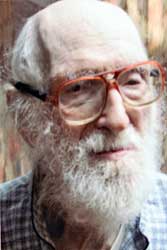Irving Fierstein, a peoples’ artist
By
Sue Davis
Published Jun 11, 2009 8:10 PM
|
Irving Fierstein in 2008.
Photo: Bob Fierstein
|
For the better part of the last 75 years, revolutionary peoples’ artist
Irving Fierstein used his immense talent to depict the many struggles of
working and oppressed people for social and economic justice and against
imperialism. In the early 1980s Fierstein created a unique genre of
art—striking full-color revolutionary banners thoughtfully composed and
painstakingly painted by hand. Hundreds of Fierstein’s banners provided
visual focal points in countless marches and rallies in New York and elsewhere
for more than two decades.
Fierstein painted his first banner in 1980 when Alexander Haig attempted to
seize control of the government. A picture of the banner depicting Haig atop a
menacing tank yelling, “I’m in charge,” was carried in dozens
of newspapers across the country. Since then, Fierstein painted banners against
Reagan cutbacks, affirming lesbian, gay, bi and transgender rights, Jersey City
housing struggles, protests against police violence, and any number of U.S.
invasions.
Perhaps the most famous image he created was for a 1985 New Years greeting card
of two Black fists breaking chains imposed over a map of Africa with the slogan
“Free South Africa.” Not only was the design also used on banners,
buttons and placards, but the image was adopted all over the world to symbolize
the struggle against apartheid. Monica Moorehead, a founder of the U.S. Out of
Southern Africa Network, commented, “Irving’s powerful Free South
Africa image truly captured the spirit of this heroic national liberation
struggle. The image became an important part of mass culture as well, as it
appeared in the movies ‘School Daze’ and ‘Cry Freedom’
and also on the front cover of Esquire.”
Not only did Fierstein’s art appear on leaflets and other printed
materials, it illustrated articles in Workers World. But Fierstein’s
activism didn’t end there. The artist was often the first one on a picket
line or at a meeting. Always enthusiastic and optimistic, Fierstein was as
generous with his resources as with his talent. He made significant monthly
donations to the Workers World Supporter Program for over 30 years.
In 2001 Sara Flounders, an International Action Center co-coordinator in New
York, organized an exhibit to show the range of his art work. “It was a
spectacular exhibit,” Flounders told Workers World. “The walls of
the large IAC Center on 14th Street were covered with paintings expressing rage
at the bankers and CEOs, pain for the millions starving during the Iraq
Sanctions, the power of the Black Liberation struggle, and the chaos of
capitalist plunder interspersed with banners of past demonstrations.
“Working with Irving on planning what to display and how to fit it in the
IAC brought back years of struggle and street confrontations.” His
daughter Laurie Fierstein, an organizer of Youth Against War & Fascism,
Women United for Action and Workers World, said that the show “meant a
lot to him.”
Anti-Zionist Jewish fighter
Born of Polish and Rumanian Jewish immigrant parents in 1915, Fierstein
discovered his talent and love of art while a youth in Williamsburg, Brooklyn.
He studied art and architecture at the Hebrew Technical Institute, but, unable
to find work in his field, he turned to commercial art at Cooper Union. He also
studied fine art at the Art Students’ League and the National Academy of
Design, where he won an award in 1937.
Like many youth during the Great Depression, Fierstein joined the progressive
movement. In 1935 he attempted to organize a Commercial Artists and Designers
Union and helped to paint a giant Times Square billboard in support of Spanish
Civil War anti-fascist freedom fighters in 1938. During that time he became
active in the Communist Party.
In 1948 Fierstein took a principled stand when U.S. and British imperialism,
working with the Zionist movement, occupied Palestine to set up the Israeli
settler state. He was vocal in defense of the Palestinian people’s right
to their homeland, which was highly unusual for someone raised Jewish. Even
though that meant opposing the international socialist movement, which at the
time nearly unanimously supported the Israeli state, Fierstein never wavered in
his support for the rights of Palestinian people.
Fierstein resumed his art studies in the 1960s when he learned of the beating
of civil rights activist Fanny Lou Hamer in a Mississippi jail. His oil of that
shameful event painted in 1969 now hangs in the Martin Luther King Jr. Center
for Social Change in Atlanta. Over the years his oils, acrylics, lithographs,
etching and mixed media were exhibited at several fine art New York galleries.
This father of four continued to paint into his 90s.
A dedicated chess player, jazz aficionado and vegetarian cook, Fierstein was an
accomplished athlete. At age 74 he won gold medals in racewalk races and
finished first in his age category in the New York City Marathon. In his 80s
Fierstein battled cancer with the same vengeance he pursued politics. He died
from respiratory failure on May 25 at age 94.
Fierstein’s contributions to the many struggles he portrayed are
legendary. They will be remembered by his many friends, comrades and family on
July 19 in New York’s Solidarity Center. Irving Fierstein, presente!
Articles copyright 1995-2012 Workers World.
Verbatim copying and distribution of this entire article is permitted in any medium without royalty provided this notice is preserved.
Workers World, 55 W. 17 St., NY, NY 10011
Email:
[email protected]
Subscribe
[email protected]
Support independent news
DONATE


